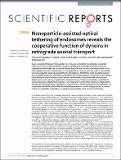Nanoparticle-assisted optical tethering of endosomes reveals the cooperative function of dyneins in retrograde axonal transport
Author(s)
Chowdary, Praveen D.; Che, Daphne L.; Kaplan, Luke; Chen, Ou; Pu, Kanyi; Cui, Bianxiao; Bawendi, Moungi G.; ... Show more Show less
DownloadChowdary-2015-Nanoparticle-assisted.pdf (1.649Mb)
OPEN_ACCESS_POLICY
Open Access Policy
Creative Commons Attribution-Noncommercial-Share Alike
Terms of use
Metadata
Show full item recordAbstract
Dynein-dependent transport of organelles from the axon terminals to the cell bodies is essential to the survival and function of neurons. However, quantitative knowledge of dyneins on axonal organelles and their collective function during this long-distance transport is lacking because current technologies to do such measurements are not applicable to neurons. Here, we report a new method termed nanoparticle-assisted optical tethering of endosomes (NOTE) that made it possible to study the cooperative mechanics of dyneins on retrograde axonal endosomes in live neurons. In this method, the opposing force from an elastic tether causes the endosomes to gradually stall under load and detach with a recoil velocity proportional to the dynein forces. These recoil velocities reveal that the axonal endosomes, despite their small size, can recruit up to 7 dyneins that function as independent mechanical units stochastically sharing load, which is vital for robust retrograde axonal transport. This study shows that NOTE, which relies on controlled generation of reactive oxygen species, is a viable method to manipulate small cellular cargos that are beyond the reach of current technology.
Date issued
2015-12Department
Massachusetts Institute of Technology. Department of ChemistryJournal
Scientific Reports
Publisher
Elsevier
Citation
Chowdary, Praveen D., Daphne L. Che, Luke Kaplan, Ou Chen, Kanyi Pu, Moungi Bawendi, and Bianxiao Cui. “Nanoparticle-Assisted Optical Tethering of Endosomes Reveals the Cooperative Function of Dyneins in Retrograde Axonal Transport.” Scientific Reports 5 (December 10, 2015): 18059.
Version: Final published version
ISSN
2045-2322